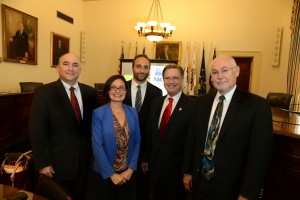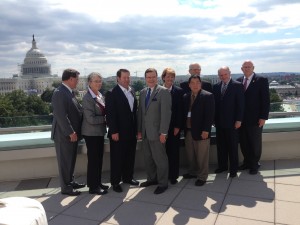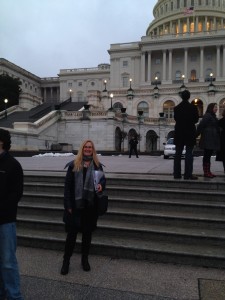Author Archive
ASCE Past President Flies Over Pittsburgh on 60 Minutes
November 24th, 2014 | By: Becky Moylan
ASCE Past President Andy Herrmann flew over the “city of bridges” with 60 Minutes’ Steve Kroft to highlight America’s aging bridges in a segment that aired Sunday, Nov. 23. Falling apart: America’s neglected infrastructure Herrmann was among several experts interviewed for the piece, including former Secretary of Transportation Ray LaHood and Congressman Earl Blumenauer (D-OR). While each guest brought different experiences, they all agreed on one thing: the need for increased funding. One in nine bridges in the U.S. are structurally deficient and the gas tax, last increased in 1993, simply cannot fully-fund a 2014 transportation network. As Herrmann said, “It all comes down to funding.” It is now up to Congress to #FixTheTrustFund with a long-term, sustainable funding solution that will address our aging infrastructure.Tags: bridges, highway trust fund, Report Card for America's Infrastructure, roads
1 Comment »
ASCE Past President Andy Herrmann To Talk Infrastructure with 60 Minutes
November 21st, 2014 | By: Becky Moylan
This Sunday, Nov. 23, ASCE Past President Andrew W. Herrmann, P.E. SECB, F.ASCE, will discuss the state of our nation’s bridges during primetime TV on CBS’ 60 Minutes via a helicopter tour of Pittsburgh. 60 Minutes Video – The roads and bridges Americans drive on every day are in dire need of repair or replacement As the Highway Trust Fund heads once again toward insolvency, 60 Minutes chronicles the need for increased investment across the U.S. with interviews from former Secretary of Transportation Ray LaHood and Rep. Earl Blumenauer. Each with a unique perspective on infrastructure, all these guests will echo the same message: #FixTheTrustFund with a long-term, sustainable funding solution. Host a viewing party, set your DVR, and tell your friends and family to tune in at 7:30 p.m. ET/7 p.m. PT to see ASCE tell the story behind our nation’s bridges.Tags: 60 minutes, bridges, highway trust fund, infrastructure, Report Card for America's Infrastructure, roads
4 Comments »
21-Year-Old Gas Tax Rate Still Holding Up America’s Roads & Bridges
October 1st, 2014 | By: Becky Moylan
The following is a statement from Randall (Randy) S. Over, P.E., F.ASCE, president of the American Society of Civil Engineers (ASCE), regarding the 21st anniversary of the last federal gas tax increase: “Today the federal gas tax’s 18.4-cent rate turns 21. While this is a rite of passage for American college students, this milestone is a sad reflection on Congressional inaction when it comes to our transportation system. According to the Consumer Price Index many household prices have nearly doubled in the past 21 years.- A loaf of bread cost: 1993: $0.75, 2014: $1.39.
- A pound of coffee: 1993: $2.50, 2014: $5.16.
Tags: bridges, gas tax, highway trust fund, roads, transit
No Comments »
Maximizing the Investment in Transportation Projects
October 1st, 2014 | By: Becky Moylan
ASCE teamed with the Eno Center for Transportation to author Maximizing the Value of Investments Using Life Cycle Cost Analysis. The report, released yesterday at a Capitol Hill briefing, surveyed industry practitioners and policymakers on their current use of life cycle cost analysis (LCCA), and their beliefs on what role it should play in the decision-making process. It also features six case studies that demonstrate the benefits of implementing LCCA. While almost all those surveyed said it should be part of the process, only 59% said it was currently being used.
Greg Nadeau, Beth Osborne, Joshua Schank (Eno), Pat Natale (ASCE), and Chris Stone all offered their perspectives on the value of LCCA. Photo by Neshan H. Naltchayan
Tags: infrastructure investment, LCCA, life cycle cost analysis, life cycle costs, surface transportation, transportation
1 Comment »
New ASCE Report Offers Recommendations to Maximize Transportation Project Funding
September 30th, 2014 | By: Becky Moylan
Despite the majority of transportation industry practitioners’ agreement that the full cost of a project—including long-term operation and maintenance—should be considered in decision-making, only 48 percent of practitioners said their agencies could effectively predict future costs, according to a survey released as part of a new report by the American Society of Civil Engineers (ASCE) and the Eno Center for Transportation (Eno). State and federal funding for transportation projects is stagnant, yet Maximizing the Value of Investments Using Life Cycle Cost Analysis finds that currently most transportation funding is invested without considering long-term operating costs. To improve decision making, the report gives a series of policy recommendations on how to implement Life Cycle Cost Analysis (LCCA), a process which ensures total costs related to an asset— including the cost to operate the infrastructure in the future—is accounted for. “Considering the full cost of a project throughout its lifespan is essential if we want to make the best investment with the limited funding available,” said Pat Natale, Executive Director, ASCE. “There is a clear desire to use this more in the transportation industry. Now is the time for our policymakers to incentivize using LCCA to ensure we choose the right project and design options.” “Far too often not enough analysis goes into transportation investment decisions as the emphasis is placed on upfront costs rather than long-term costs and benefits,” said Eno President and CEO Joshua Schank. “Both local and federal planners and policymakers can make a difference in the future of this country’s transportation and infrastructure network by implementing life cycle cost analysis.” According to the report’s survey of industry decision-makers, operation and maintenance costs are pressing concerns. Yet, less than half of respondents had an “operations plan” as part of the planning process. Life cycle cost analysis considers these costs associated with a project and can help inform which projects are selected, to ensure the best use of funding. Through case studies, the report also finds that:- Using data-driven analysis can save agencies money by improving project selection. In Denver, the use of life cycle cost analysis saved the Regional Transit District $300 million.
- The private sector can play an important role in incorporating life cycle cost analysis in project design and selection, as it already is a leader in considering operation and maintenance costs.
- There is an opportunity for the federal government to provide more incentives to tie agency performance to funding.
Advocate Profile: Marsia Geldert-Murphey, P.E., M.ASCE
September 24th, 2014 | By: Becky Moylan
Advocate Profile: Marsia Geldert-Murphey, P.E., M.ASCE Marsia Geldert-Murphey, P.E., M. ASCE is the incoming chair of ASCE’s Public Policy Committee. As president and CEO of Sequoia Engineering & Environmental, Inc. she is responsible for overall management, development and growth of firm specializing in geotechnical engineering, environmental documentation & permitting, construction engineering and public involvement. If you are interested in becoming involved in ASCE’s Key Contact program and promoting the profession through advocacy, you can learn more information and sign up at asce.org. How did you become interested in and get involved in advocacy for your profession? Many years ago at an ASCE conference I heard about the Key Contact program and felt it would be a great way to stay well-informed of legislation affecting our profession. However, I must confess initially I was not the most dedicated at reaching out to my legislators. As I advanced in my career, I began to see the effect certain legislation had on our profession and business and I became more engaged both at the local and state level. What levels of government have you focused your efforts on? Is there something that prompted you to focus your efforts there? Instead of focusing on a certain level of government, I simply stay appraised of proposed bills, executive orders and amendments that affect my livelihood and our quality of life. I try to keep other people informed which is much easier with social media platforms like LinkedIn, Facebook and Twitter. People are busy and want to focus on what they know, the workings of the government at any level can be intimidating or at times frustrating. So I want to make sure I increase the pool of knowledge and get as much information out to my network as possible. I have had several people in the industry thank me for keeping them up to date. How do you gather information and prepare to do your advocacy work? I am usually made aware of state and federal issues by ASCE’s Government Relations staff. I am always impressed with how quickly they will hear of proposed language, especially at the state level. Effective advocacy does require research. I review the language of the proposed bill and any position or summary papers out there. I reach out to my network of legislators, staffers and lobbyists to understand the intent, benefits and potential pitfalls of any proposed rules or legislation. I share my feedback and make sure they understand the impacts good and bad. What have you learned through your activities as an ASCE advocate and citizen lobbyist? I have learned a couple things over the years. A small group of concerned citizens can actually make a difference. I have also learned that it is critical to stay informed and become involved. Well-meaning legislation can quickly pass through without a thorough understanding of the impacts to small business or our profession. Has the experience helped you improve skills you utilize personally or professionally? Absolutely, while most people would think advocacy is about persuasion, I believe it is about credibility and character, and I believe my involvement has enhanced my credibility in the industry. My advocacy work has also refined my listening and communication skills. What has been challenging about being an advocate? What methods have you found effective in working through those challenges? What sort of pitfalls or setbacks have you encountered? And how did you overcome them? The greatest challenge is understanding the political dynamics, particularly at the federal level. You cannot go into this being single-minded, you have to understand the broader interests at stake. The other challenge is the slow rate of progress, it can be very frustrating, and this requires stamina and patience. Some of the pitfalls I have encountered are simply the lack of political will to make tough decisions. I try to understand where the resistance is coming from, find common ground and form alliances around those areas we can agree on, and slowly gain traction from there. What have you found rewarding about your efforts? Is there a particularly memorable experience you can share? The most rewarding moments are when hard-fought-for legislation passes, with meaningful language still intact. The most memorable experience for me was sitting at ASCE’s Washington, DC office recently while in town for the Transportation Construction Coalition (TCC) Fly-in and watching footage of the President signing the Water Resources Reform and Development Act (WRRDA) into law. It was very fitting that I happened to be there with the ASCE Government Relations staff witnessing that signing, they worked very hard on our behalf for that legislation. Have you felt that your efforts have made a difference? Yes, our legislators want to hear from their constituents. Many people complain about the influence lobbyists have in Washington, however, they have never contacted their legislators. I have worked with legislators requesting endorsements of amendments beneficial to the civil engineering profession, so I know my efforts are making a difference. What advice would you give to someone interested in getting involved in advocacy? The most important step is sign up as a key contact at ASCE. The Government Relations staff are your boots on the ground and will keep you informed. Consider becoming an advocate champion within your Section or Branch to inform members and colleagues in your area.State Legislators Invited to Dream Big!
September 23rd, 2014 | By: Becky Moylan
Last week, ASCE hosted state legislators from nine states at the Washington office as part of a Council of State Governments (CSG) Transportation Policy Academy. ASCE has been a regular sponsor of these forums that bring state legislative leaders together to discuss transportation issues and the challenges they are facing in their respective states. In addition to a presentation on the 2013 Report Card for America’s Infrastructure, the event also featured a luncheon presentation on plans for an IMAX movie Dream Big!, which ASCE and the ASCE Foundation are pursuing to put engineering dramatically in the public eye. Lawmakers from Georgia, Hawaii, Kentucky, Nebraska, New Hampshire, North Carolina, South Dakota, Vermont and Washington were in attendance.
State Legislators visit ASCE’s Washington office during the recent CSG Policy Academy. L-R: Rep. Curtis King (R-Washington), Rep. Patricia Higgins (D-New Hampshire), Rep. Jay Roberts (R-Georgia), Sen. Mike Vehle (R-South Dakota), Rep. Diane Lanpher (D-Vermont), Rep. Ryan Yamane (D-Hawaii), Sen. Ernie Harris (R-Kentucky), Sen. Jim Smith (NP-Nebraska), Rep. William Brawley (R-North Carolina)
Tags: CSG, dream big, state government, transportation
No Comments »
ASCE Applauds U.S. House T&I Committee’s Bipartisan Report on Public-Private Partnership
September 17th, 2014 | By: Becky Moylan
The following is a statement from Randall (Randy) S. Over, P.E., F.ASCE, president of the American Society of Civil Engineers (ASCE) regarding the U.S. House of Representatives’ Transportation & Infrastructure Committee’s special panel report, Public-Private Partnerships: Balancing the Needs of the Public and Private Sectors to Finance the Nation’s Infrastructure, on the use of Public-Private Partnerships (P3s) to improve the nation’s infrastructure: “Public-Private Partnerships (P3s) are a valuable form of financing for infrastructure projects. They have proven effective in projects across multiple sectors of infrastructure, as evident in the report released today. Similar to last week’s Infrastructure Investment Summit hosted by the Obama Administration, which ASCE members attended, bipartisan conversations like this one are crucial in ensuring we are leveraging all the potential dollars available to modernize our nation’s infrastructure. This special panel’s efforts indicate strides are being made in the dialogue. “ASCE agrees with the report’s assessment that P3s are not the silver bullet to address our nation’s infrastructure investment deficit. The nation needs a boost in traditional funding, as well. In the 2013 Report Card for America’s Infrastructure, our nation received a D+ GPA. That grade indicates we have a large investment need; one that requires leadership on all levels on government. The U.S. Congress must continue to strive for sustainable, long-term funding sources to improve and maintain our infrastructure. It should begin by addressing the Highway Trust Fund’s insolvency before the end of this year. By doing so, Congress will shorten the uncertainty for states as they plan transportation projects.”Tags: highway trust fund, P3s
2 Comments »
Investment in Water Infrastructure Works
September 12th, 2014 | By: Becky Moylan
So often, our water infrastructure goes unnoticed until a pipe bursts. Lately, there have been several events drawing attention to the water sector’s significance, including the water main break at UCLA, algae in Toledo drinking water, and drought in California. Water infrastructure deserves our attention and investment for many reasons, beyond the most recent media attention. This week, ASCE co-hosted Water Works!, a day of events highlighting the economic value in the water sector. The legislative day in Washington, D.C. included the release of a report, which emphasizes the economic impact of water, wastewater and storm water utilities.
Rep. Bob Gibbs, Mayor Kevin Faulconer, and Sen. Ben Cardin sharing their thoughts on the importance of water infrastructure for our economy.
The report, National Economic & Labor Impacts of the Water Utility Sector, reveals the sector supports $524 billion in economic activity. Furthermore, in the next decade the utilities will include 289,000 jobs.
Congressional leaders and public officials shared their thoughts on the importance of investment in infrastructure during a press briefing, which emphasized the bipartisan agreement of water infrastructure investment. “Water infrastructure is a priority we cannot allow to remain unaddressed,” remarked Rep. Tim Bishop, Ranking Member on the Subcommittee on Water Resources and the Environment, as a call to action to “build on the accomplishments of WRRDA.” The importance of the water sector was underscored in Sen. Ben Cardin’s comments, as he pointed to the sector’s role in public safety and job growth. Rep. Bob Gibbs, Chair of the Subcommittee on Water Resources and the Environment echoed those sentiments, and noted that the aging infrastructure is costing us millions of dollars as valuable water is being lost each day through leaky pipes and breaks. Following the press briefing, a panel of local water leaders shared their water infrastructure investment success stories. The conversation centered around ensuring safe, reliable and affordable water. Wednesday’s events showcase the continuous effort and conversation surrounding improving the nation’s D grade water infrastructure. You can get involved and increase the ripple effect by learning more about the report and utilizing the data to showcase the economic benefits of water infrastructure investment. As Mayor Kevin Faulconer of San Diego said at the event, “There is no better time to invest.”Tags: economy, jobs, Water Works, wrrda
No Comments »



 */ ?>
*/ ?>















